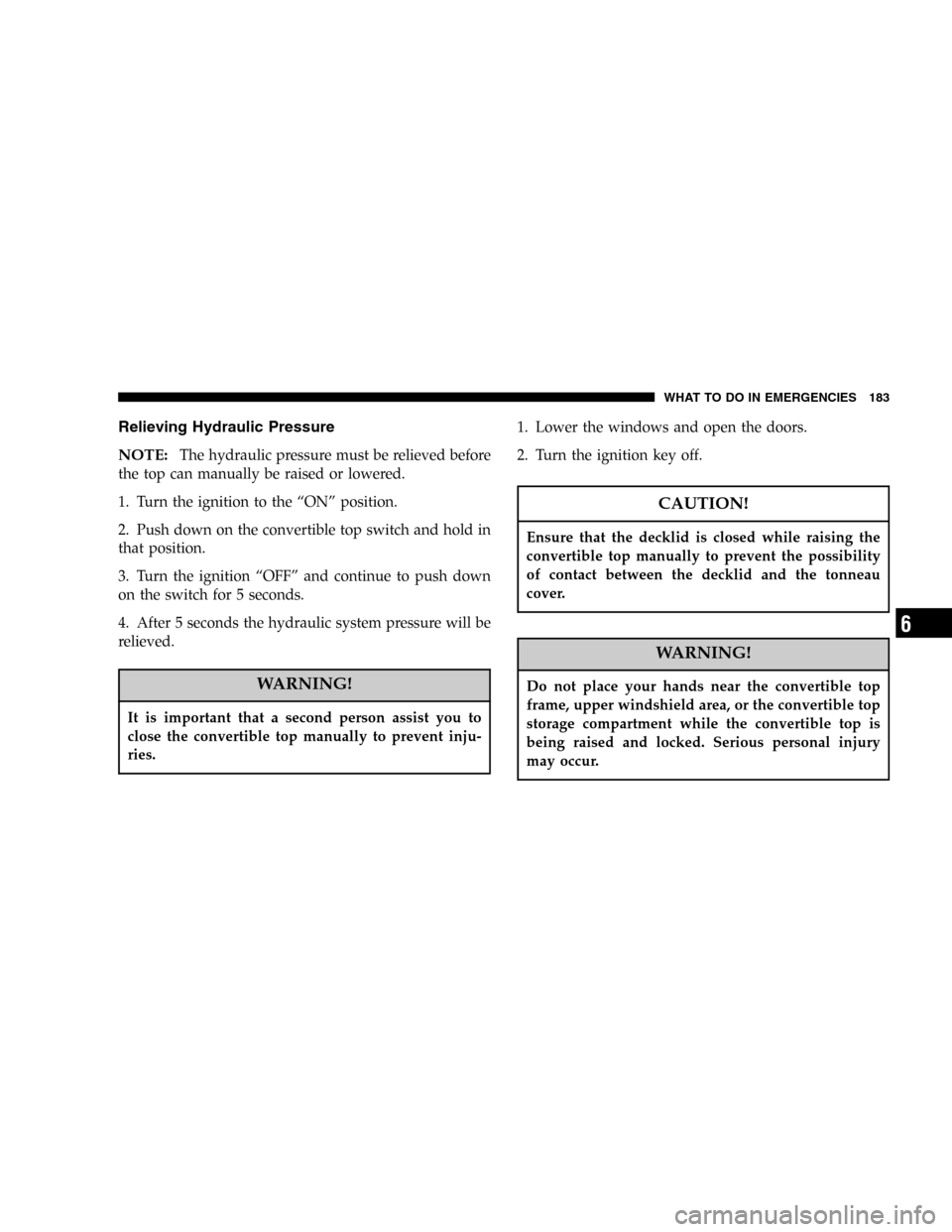Page 178 of 280

TOWING A DISABLED VEHICLE
We recommend that the vehicle be transported using flat
bed equipment. This method is preferable to other types
of towing.
CAUTION!
Important! If towing the vehicle, please note the
following: With the automatic central locking acti-
vated and the key in the ignition switch turned to the
ON/RUN position, the vehicle doors lock if the left
front wheel and the right rear wheel are turning at
vehicle speeds of approximately 9 mph (15 km/h) or
more. To prevent the vehicle door locks from lock-
ing, deactivate the automatic central locking.
CAUTION!
If the vehicle is towed with the front wheels raised,
the engine must be shut off (key in the ignition
switch turned to the OFF/LOCK or ACC positions).
Otherwise, the ESP will immediately be engaged
and will apply the rear wheel brakes. Switch off the
tow-away alarm as well as the automatic central
locking system.
Towing restrictions for vehicles with automatic transmis-
sion: The vehicle may be towed with all wheels on the
ground and the transmission selector lever in the Neutral
position for distances up to 30 miles (48 km) and at a
speed not to exceed 30 mph (48 km/h). The key must be
turned to the ON/RUN position in the ignition. To be
certain to avoid a possibility of damage to the transmis-
sion, however, we recommend the drive shaft be discon-
nected at the rear axle drive flange for any towing
beyond a short tow to a nearby garage.
Always comply with applicable state or local towing
ordinances.
178 WHAT TO DO IN EMERGENCIES
Page 183 of 280

Relieving Hydraulic Pressure
NOTE:
The hydraulic pressure must be relieved before
the top can manually be raised or lowered.
1. Turn the ignition to the“ON”position.
2. Push down on the convertible top switch and hold in
that position.
3. Turn the ignition“OFF”and continue to push down
on the switch for 5 seconds.
4. After 5 seconds the hydraulic system pressure will be
relieved.
WARNING!
It is important that a second person assist you to
close the convertible top manually to prevent inju-
ries.
1. Lower the windows and open the doors.
2. Turn the ignition key off.
CAUTION!
Ensure that the decklid is closed while raising the
convertible top manually to prevent the possibility
of contact between the decklid and the tonneau
cover.
WARNING!
Do not place your hands near the convertible top
frame, upper windshield area, or the convertible top
storage compartment while the convertible top is
being raised and locked. Serious personal injury
may occur.
WHAT TO DO IN EMERGENCIES 183
6
Page 204 of 280

Chassis Lubrication
Front Suspension Ball Joints
There are two front suspension lower ball joints that are
permanently lubricated. Inspect these ball joints when-
ever under-vehicle service is done.
Steering Linkage
Inspect tie rod ends whenever the vehicle is serviced.
They are permanently lubricated and do not require
periodic lubrication.
Drive Shaft Universal Joints
Your vehicle has four constant velocity universal joints.
Periodic lubrication of these joints is not required. How-
ever, the joint boots should be inspected for external
leakage or damage when other maintenance is per-
formed.
If leakage or damage is evident, replace the universal
joint boot and grease immediately.
Continued operation could result in failure of the univer-
sal joint due to water and dirt contamination of the
grease. This would require complete replacement of the
joint assembly.
Body Lubrication
Locks and all body pivot points, including such items as
seat tracks, doors, and rear liftgate / decklid hinges,
should be lubricated periodically to assure quiet, easy
operation and to protect against rust and wear.
Hood Latch
When performing other under hood services, the hood
latch release mechanism and safety catch should be
inspected, cleaned, and lubricated.
204 MAINTAINING YOUR VEHICLE
Page 205 of 280

It is important to maintain proper lubrication to insure
that the hood mechanisms work properly and safely.
Multi-Purpose Lubricant, NLGI Grade 2, should be ap-
plied sparingly to all pivot and sliding contact areas.
Driver’s Door Lock Cylinder
The driver’s door lock cylinder should be lubricated
twice a year, preferably in the fall and spring. Apply a
small amount of a high quality lubricant, such as Mopar�
Lock Cylinder Lubricant directly into the lock cylinder
(avoid excess lubricant).
Insert the key into the lock cylinder and rotate from the
unlocked to the locked position without adding more
lubricant. Repeat this procedure three or four times. Wipe
all the lubricant off the key with a clean cloth, to avoid
soiling clothing.
Windshield Wiper Blades
Clean the rubber edges of the wiper blades and the
windshield periodically with a sponge or soft cloth and a
mild non-abrasive cleaner, or use the washer solvent.
This will remove accumulations of salt or road film and
help reduce streaking and smearing.Operation of the wipers on dry glass for long periods
may cause deterioration of the wiper blades. Always use
washer fluid when using the wipers to remove salt or dirt
from a dry windshield. Avoid using the wiper blades to
remove frost or ice from the windshield. Make sure that
they are not frozen to the glass before turning them on to
avoid damaging the blade. Keep the blade rubber out of
contact with petroleum products such as engine oil,
gasoline, etc.
Windshield Wiper Blade Replacement
1. Lift the wiper arm away from the glass.
2. Rotate the blade 45 degrees to gain access to the
release tab.
3. Push the release tab as shown in the illustration and
slide the wiper blade assembly down along the arm.
Gently place the wiper arm on the windshield.
MAINTAINING YOUR VEHICLE 205
7
Page 221 of 280

Wet Cleaning
Wash with clear water or with a mild detergent and an
ample supply of luke warm water by wiping with a
soft-bristled brush or sponge from front to rear. Then
rinse thoroughly with clear water.
Allow the top to dry before lowering. Vacuuming the top
with a wet/dry shop vacuum will decrease the top’s
drying time, ensure removal of all dirt, and delete streaks
in the material. Multiple cleanings may be necessary to
remove stubborn stains. If stains persist, contact your
local dealership for further suggestions.
Weather Strip Care
Lubricate all top and door glass weather strips periodi-
cally with Mopar Weather Strip Lubricant (part number
4773427), to keep them soft and pliable.
FUSES
Underhood Accessory Fuse Block Fuses
The underhood accesseory fuse block fuses are located
under the hood on the driver’s side, between the brake
master cylinder and the left front fender.
To remove the lid, squeeze the tabs together located at the
front of the fusebox. Then lift the lid up by the tabs. The
lid will then slide off the top of the fuse box. To replace
the lid, place the two hinge-like tabs at the rear of the lid
under the tabs on the fusebox. Push down on the front of
the lid until the tabs at the front click.
MAINTAINING YOUR VEHICLE 221
7
Page 223 of 280
Underhood Accessory Fuse Block Fuses
Cavity Fuse Circuits
1 5 Amp
BeigeGarage Door Opening Signal,
TPM and Seat Heater
2 5 Amp
BeigeOccupant Restraint Controller
Passenger Airbag Off
3 5 Amp
BeigeIndicator, Safety Restraint System
and Indicator, Passenger Airbag
Off
4 7.5 Amp
BrownHeated Mirror
5 15 Amp
BlueRadio (Coupe)
5 25 Amp
WhiteRoof Control Module (Roadster)
6 5 Amp
BeigeExterior Mirror Adjustment, Left
And Right (Coupe)
6 40 Amp
OrangeRoof Hydraulic Unit (Roadster)
7 5 Amp
BeigeElectronic Transmission Control
(Park/Reversing Lock) and BCM
MAINTAINING YOUR VEHICLE 223
7
Page 230 of 280
4. Realign the two tabs and push the light in until it
engages into the lock.
Tail, Stop, Back Up and Turn Signal Lights
1. Open the rear liftgate / decklid and remove the access
door in the trim panel.
2. Twist the bulb socket counterclockwise and pull out.
3. Replace the light and return to open socket, turn
clockwise until it stops.
4. Replace the access door in the trim panel.
License Plate Light
1. Remove the two lens assembly mounting screws.
2. Pull the bulb out of the socket.
3. Replace the bulb and reattach the lens assembly.
4. Align and resecure the two lens assembly mounting
screws.
NOTE:Be sure not to over-torque the mounting screws
or permanent damage to the lens may occur.
230 MAINTAINING YOUR VEHICLE
Page 232 of 280

•If the vehicle will be subjected to freezing tempera-
tures, remove the battery and store it in a dry, well-
ventilated place. If the vehicle is not going to be driven
in the next three weeks, follow the battery recharge
procedure in the Service Manual, then disconnect the
battery at the negative terminal.
CAUTION!
Use care when disconnecting the remote positive
cable. It is connected to the battery and can short out
to any metal on the vehicle. Always tape or wrap the
exposed cable end to prevent electrical shorts.
Disconnecting the battery causes the engine control sys-
tem to lose memory of some“learned”functions. The
engine may run rough when first started after a battery
disconnect until the control module“relearns”these
functions.Check the battery every four to six weeks to ensure that
the voltage is above 12.40. Voltage will drop more rapidly
in hot temperatures. If battery voltage drops below 12.40,
follow the battery recharge procedure in the Service
Manual.
•Check that the radiator coolant level of protection is to
at least -20°F (-29°C).
•Block the wheels. Do not apply the parking brake.
•Make sure that all tires are inflated to the optimum
pressure.
•Cut blocks of plywood about the same size of the tires.
Cover each block with indoor/outdoor carpeting and
place them between the tires and concrete. This will
prevent tire flat spotting.
•For long term storage, remove the tires and put the
vehicle up on blocks. Stack the tires on plywood and
cover with a tarp to prevent flat spotting.
•Move the wiper blades away from the windshield.
232 MAINTAINING YOUR VEHICLE